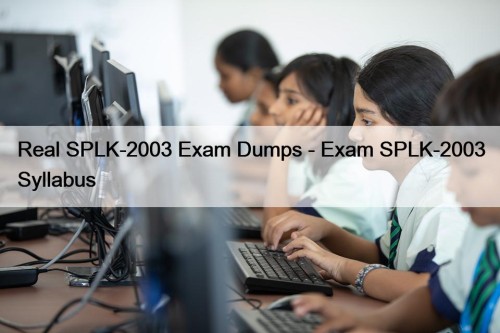Most Popular
 Latest DMF-1220 Exam Preparation & DMF-1220 Reliable Practice Materials
Latest DMF-1220 Exam Preparation & DMF-1220 Reliable Practice Materials
There are lots of benefits of obtaining a certificate, it ...
 Salesforce Certified B2B Solution Architect Exam latest study torrent & Salesforce Certified B2B Solution Architect Exam reliable vce pdf & Salesforce Certified B2B Solution Architect Exam valid training dumps
Salesforce Certified B2B Solution Architect Exam latest study torrent & Salesforce Certified B2B Solution Architect Exam reliable vce pdf & Salesforce Certified B2B Solution Architect Exam valid training dumps
What's more, part of that TestPDF B2B-Solution-Architect dumps now are ...
 Real SPLK-2003 Exam Dumps - Exam SPLK-2003 Syllabus
Real SPLK-2003 Exam Dumps - Exam SPLK-2003 Syllabus
BTW, DOWNLOAD part of TrainingDump SPLK-2003 dumps from Cloud Storage: ...



Real SPLK-2003 Exam Dumps - Exam SPLK-2003 Syllabus

BTW, DOWNLOAD part of TrainingDump SPLK-2003 dumps from Cloud Storage: https://drive.google.com/open?id=1ySfMUqTAfflyLMnIsYHwtkxUH_1B6XxG
In order to give the best SPLK-2003 study braindumps to our worthy customers, we also focus on the customer's user experience. Our staff provides you with the smoothest system. If you have encountered some problems while using SPLK-2003 Practice Guide, you can also get our timely help as our service are working 24/7 online. Of course, our SPLK-2003 exam questions are advancing with the times and you will get the latest information.
Splunk SPLK-2003 Exam Syllabus Topics:
| Topic | Details |
|---|---|
| Topic 1 |
|
| Topic 2 |
|
| Topic 3 |
|
| Topic 4 |
|
| Topic 5 |
|
| Topic 6 |
|
| Topic 7 |
|
| Topic 8 |
|
| Topic 9 |
|
| Topic 10 |
|
| Topic 11 |
|
| Topic 12 |
|
| Topic 13 |
|
| Topic 14 |
|
>> Real SPLK-2003 Exam Dumps <<
Pass Guaranteed Quiz 2025 Splunk SPLK-2003 Updated Real Exam Dumps
The modern Splunk world is changing its dynamics at a fast pace. To stay and compete in this challenging market, you have to learn and enhance your in-demand skills. Fortunately, with the Splunk Phantom Certified Admin (SPLK-2003) certification exam you can do this job nicely and quickly. To do this you just need to enroll in the SPLK-2003 certification exam and put all your efforts to pass the Splunk Phantom Certified Admin (SPLK-2003) certification exam. After successful competition of the Splunk SPLK-2003 certification, the certified candidates can put their career on the right track and achieve their professional career objectives in a short time period.
Splunk Phantom Certified Admin Sample Questions (Q53-Q58):
NEW QUESTION # 53
What is the main purpose of using a customized workbook?
- A. Workbooks automatically implement a customized processing of events using Python code.
- B. Workbooks apply service level agreements (SLAs) to containers and monitor completion status on the ROI dashboard.
- C. Workbooks guide user activity and coordination during event analysis and case operations.
- D. Workbooks may not be customized; only default workbooks are permitted within Phantom.
Answer: C
Explanation:
The main purpose of using a customized workbook is to guide user activity and coordination during event analysis and case operations. Workbooks can be customized to include different phases, tasks, and instructions for the users. The other options are not valid purposes of using a customized workbook. See Workbooks for more information.
Customized workbooks in Splunk SOAR are designed to guide users through the process of analyzing events and managing cases. They provide a structured framework for documenting investigations, tracking progress, and ensuring that all necessary steps are followed during incident response and case management. This helps in coordinating team efforts, maintaining consistency in response activities, and ensuring that all aspects of an incident are thoroughly investigated and resolved. Workbooks can be customized to fit the specific processes and procedures of an organization, making them a versatile tool for managing security operations.
NEW QUESTION # 54
What is the primary objective of using the I2A2 playbook design methodology?
- A. To meet customer requirements using a single playbook.
- B. To create detailed playbooks.
- C. To create playbooks that customers will not edit.
- D. To create simple, reusable, modular playbooks.
Answer: D
Explanation:
The primary objective of using the I2A2 playbook design methodology in Splunk SOAR is to create playbooks that are simple, reusable, and modular. This design philosophy emphasizes the creation of playbooks that can be easily understood and maintained, encourages the reuse of playbook components in different scenarios, and fosters the development of playbooks that can be modularly connected or used independently as needed.
I2A2 design methodology is a framework for designing playbooks that consists of four components:
*Inputs: The data that is required for the playbook to run, such as artifacts, parameters, or custom fields.
*Interactions: The blocks that allow the playbook to communicate with users or other systems, such as prompts, comments, or emails.
*Actions: The blocks that execute the core logic of the playbook, such as app actions, filters, decisions, or utilities.
*Artifacts: The data that is generated or modified by the playbook, such as new artifacts, container fields, or notes.
The I2A2 design methodology helps you to plan, structure, and test your playbooks in a modular and efficient way. The primary objective of using the I2A2 design methodology is to create simple, reusable, modular playbooks that can be easily maintained, shared, and customized. Therefore, option D is the correct answer, as it states the primary objective of using the I2A2 design methodology. Option A is incorrect, because creating detailed playbooks is not the primary objective of using the I2A2 design methodology, but rather a possible outcome of following the framework. Option B is incorrect, because creating playbooks that customers will not edit is not the primary objective of using the I2A2 design methodology, but rather a potential risk of not following the framework. Option C is incorrect, because meeting customer requirements using a single playbook is not the primary objective of using the I2A2 design methodology, but rather a challenge that can be overcome by using the framework.
1: Use a playbook design methodology in Administer Splunk SOAR (Cloud).
NEW QUESTION # 55
Which of the following roles is appropriate for a Splunk SOAR account that will only be used to execute automated tasks?
- A. Automation Engineer
- B. Non-Human
- C. Automation
- D. Service Account
Answer: C
NEW QUESTION # 56
Which of the following can the format block be used for?
- A. To generate string parameters for automated action blocks.
- B. To create text strings that merge state text with dynamic values for input or output.
- C. To generate HTML or CSS content for output in email messages, user prompts, or comments.
- D. To generate arrays for input into other functions.
Answer: B
Explanation:
The format block in Splunk SOAR is utilized to construct text strings by merging static text with dynamic values, which can then be used for both input to other playbook blocks and output for reports, emails, or other forms of communication. This capability is essential for customizing messages, commands, or data processing tasks within a playbook, allowing for the dynamic insertion of variable data into predefined text templates.
This feature enhances the playbook's ability to present information clearly and to execute actions that require specific parameter formats.
NEW QUESTION # 57
A user has written a playbook that calls three other playbooks, one after the other. The user notices that the second playbook starts executing before the first one completes. What is the cause of this behavior?
- A. Incorrect join configuration on the second playbook.
- B. The first playbook is performing poorly.
- C. The sleep option for the second playbook is not set to a long enough interval.
- D. Synchronous execution has not been configured.
Answer: D
Explanation:
In Splunk SOAR, playbooks can execute actions either synchronously (waiting for one action to complete before starting the next) or asynchronously (allowing actions to run concurrently). If a playbook starts executing before the previous one has completed, it indicates that synchronous execution has not been properly configured between these playbooks. This is crucial when the output of one playbook is a dependency for the subsequent playbook. Options B, C, and D do not directly address the observed behavior of concurrent playbook execution, making option A the most accurate explanation for why the second playbook starts before the completion of the first.
synchronous execution is a feature of the SOAR automation engine that allows you to control the order of execution of playbook blocks. Synchronous execution ensures that a playbook block waits for the completion of the previous block before starting its execution. Synchronous execution can be enabled or disabled for each playbook block in the playbook editor, by toggling the Synchronous Execution switch in the block settings.
Therefore, option A is the correct answer, as it states the cause of the behavior where the second playbook starts executing before the first one completes. Option B is incorrect, because the first playbook performing poorly is not the cause of the behavior, but rather a possible consequence of the behavior. Option C is incorrect, because the sleep option for the second playbook is not the cause of the behavior, but rather a workaround that can be used to delay the execution of the second playbook. Option D is incorrect, because the join configuration on the second playbook is not the cause of the behavior, but rather a way of merging multiple paths of execution into one.
1: Web search results from search_web(query="Splunk SOAR Automation Developer synchronous execution")
NEW QUESTION # 58
......
At the TrainingDump offer students Splunk SPLK-2003 practice test questions, and 24/7 support to ensure they do comprehensive preparation for the Splunk Phantom Certified Admin (SPLK-2003) exam. TrainingDump Splunk Phantom Certified Admin (SPLK-2003) practice test material covers all the key topics and areas of knowledge necessary to master the Splunk Certification Exam.
Exam SPLK-2003 Syllabus: https://www.trainingdump.com/Splunk/SPLK-2003-practice-exam-dumps.html
- SPLK-2003: Real Splunk Phantom Certified Admin Exam Dumps - Free PDF Quiz 2025 Unparalleled SPLK-2003 🔔 Easily obtain free download of [ SPLK-2003 ] by searching on ⏩ www.examdiscuss.com ⏪ ⚔SPLK-2003 Latest Braindumps Questions
- Latest SPLK-2003 Mock Exam 🐡 SPLK-2003 Test Study Guide 📬 SPLK-2003 Latest Braindumps Questions 🙎 Open ▶ www.pdfvce.com ◀ enter ➡ SPLK-2003 ️⬅️ and obtain a free download 🚥New SPLK-2003 Practice Questions
- Real SPLK-2003 Exam Dumps 100% Pass | Latest Splunk Exam Splunk Phantom Certified Admin Syllabus Pass for sure 🎼 ( www.pdfdumps.com ) is best website to obtain ▛ SPLK-2003 ▟ for free download 🧊SPLK-2003 Authentic Exam Questions
- SPLK-2003 Authentic Exam Questions ⌨ Best SPLK-2003 Study Material ✔️ SPLK-2003 Study Material 🟨 Easily obtain ⮆ SPLK-2003 ⮄ for free download through “ www.pdfvce.com ” 👖New SPLK-2003 Test Syllabus
- Pass Guaranteed SPLK-2003 - Trustable Real Splunk Phantom Certified Admin Exam Dumps 🧵 Open ⏩ www.lead1pass.com ⏪ enter ➠ SPLK-2003 🠰 and obtain a free download 🕘New SPLK-2003 Practice Questions
- Mock SPLK-2003 Exams 🚥 Latest SPLK-2003 Mock Exam 🕌 SPLK-2003 Study Material 🤒 ➠ www.pdfvce.com 🠰 is best website to obtain “ SPLK-2003 ” for free download 🌟Mock SPLK-2003 Exams
- New SPLK-2003 Exam Book 🦳 SPLK-2003 Examcollection Vce 🍺 Latest SPLK-2003 Mock Exam 🪔 Enter ☀ www.dumpsquestion.com ️☀️ and search for “ SPLK-2003 ” to download for free 🌇Latest Braindumps SPLK-2003 Book
- New SPLK-2003 Test Syllabus 🌕 Latest Braindumps SPLK-2003 Book 🚏 Mock SPLK-2003 Exams 🟧 Open website ( www.pdfvce.com ) and search for { SPLK-2003 } for free download 🚼SPLK-2003 Authentic Exam Questions
- Best SPLK-2003 Study Material 🛬 Latest Braindumps SPLK-2003 Book 🟥 Valid Test SPLK-2003 Testking 👨 Easily obtain ➤ SPLK-2003 ⮘ for free download through ➡ www.lead1pass.com ️⬅️ 🏵Latest SPLK-2003 Mock Exam
- Prepare for sure with SPLK-2003 free update dumps - SPLK-2003 dump torrent 🍏 Download ⮆ SPLK-2003 ⮄ for free by simply searching on ▛ www.pdfvce.com ▟ 🎅Latest SPLK-2003 Mock Exam
- Very best Splunk SPLK-2003 Dumps - By Most Secure System 📱 Search for ➡ SPLK-2003 ️⬅️ and easily obtain a free download on ▛ www.torrentvce.com ▟ 🐬SPLK-2003 Exam Course
- SPLK-2003 Exam Questions
- csbskillcenter.com projectshines.com lms.nawathealth.com lms.drektashow.com robreed526.azzablog.com universalonlinea.com graphiskill.com theduocean.org asmtechnolabs.com epstopikkorea.id
DOWNLOAD the newest TrainingDump SPLK-2003 PDF dumps from Cloud Storage for free: https://drive.google.com/open?id=1ySfMUqTAfflyLMnIsYHwtkxUH_1B6XxG
Tags: Real SPLK-2003 Exam Dumps, Exam SPLK-2003 Syllabus, SPLK-2003 Valid Test Discount, SPLK-2003 Reliable Study Notes, SPLK-2003 Valid Vce